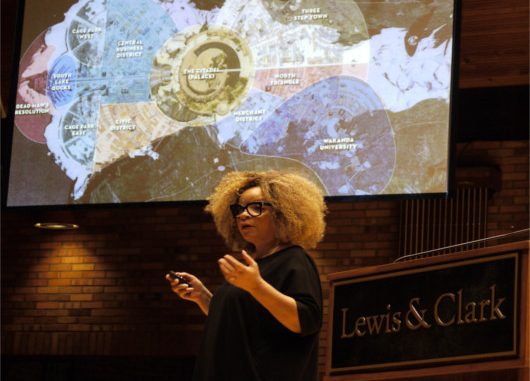
On March 20 in the Agnes Flanagan Chapel, Lewis & Clark hosted a talk by Ruth Carter, costume designer for “Black Panther. ” Carter recently won the Academy Award for Costume Design, becoming the first African-American woman to do so.
To an eager audience of students and the larger Portland community, Carter retraced her career and all that went into the costume design for “Black Panther”.
“We’re recreating and we’re changing our way of thinking about beauty because this nation is made up of many cultures that think of beauty in different ways,” Carter said.
Carter and her department also worked to creatively highlight details from the Maasai, a tribe from Kenya and Tanzania, into the film as well. Dead set on this specific piece of clothing, Carter went as far to visit Pier One Imports and transformed a placemat into something resembling the headdress.
Carter also considered how Wakandan technology would function into making their clothing, and decided to use new methods such as 3D printing to sartorially reflect the futuristic society she was designing for. Most notably, this technique was used in Angela Basset’s costume as Queen Ramonda, helping to contribute to the strength and beauty of the character through careful design only made possible by 3D printing.
Despite the costume design department’s passion and creativity, they faced many challenges in creating the diverse world of Wakanda, notably she described a debacle involving 200 blankets they had imported from southern Africa which were too stiff to work on film as they were intended. One of her assistants spent hours shaving down the blankets into a thinner version. Another one of her assistants attempted to burn layers of thread off the blankets to achieve the same effect, resulting in a horrible smell.
“We ended up shaving them all,” Carter said.
In regards to the fan-favorite Dora Milaje, the female special forces for Wakanda, Carter discussed the strenuous process of designing with the source materials and creating costumes that people could actually fight in, as well as costumes that simultaneously reflected elements of African culture.
“We really wanted to infuse as much tradition into that tabard as possible because maybe this tabard along with the other elements of this costume could be handed down to her daughter,” Carter said.
Carter knew she had accomplished something special when seeing the main cast all together in their costumes, finally embodying their characters.
“We looked at the beautiful colors, the beads and the prints and we added it all up together and we made Wakanda,” Carter said. “You can see how color and tradition and articles of costume, traditional costume, can be infused into the superhero model.”
Carter’s talk, imbued with a sense of humor and respect, emphasized the hard work and creativity that went into creating an entire society.
When asked the recurring question of how designing for a Marvel movie was different, Carter was nonplussed.
“All my career I have been a designer for superheroes; Malcolm X was a superhero, Martin Luther King was a superhero, and may I add she-roes like Tina Turner,” Carter said.
Despite Carter’s humility about the project, the detail and creativity that went into the costume design for “Black Panther” contributed to the success of the film and its meaningful impact on audiences and critics.
Subscribe to the Mossy Log Newsletter
Stay up to date with the goings-on at Lewis & Clark! Get the top stories or your favorite section delivered to your inbox whenever we release a new issue.

Leave a Reply